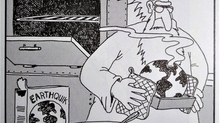What's Wrong with this Passage?
- S.D. Smith
- Nov 22, 2024
- 4 min read
Updated: Oct 29

This image is taken from Exodus 20:14 of the 1631 KJV Bible. It represents one of the more egregious mistakes of early versions. Hence, this rare edition is commonly referred to as the "Wicked Bible." Another equally severe error was made in the 1653 edition of the KJV in 1 Corinthians 6:9, which reads, "Know ye not that the unrighteous shall inherit the kingdom of God." This version is known as the "Unrighteous Bible." If you thought that all KJV Bibles were the same, you are not alone. This blog will show a brief history of the KJV and the development of previous Bible translations.
Many believers see the KJV and NKJV as two of many Bible translations. This view is simplified as will be explained, but I should first point out that only the KJV is a translation. The NKJV is not an independent translation but rather a revision of the text into modern language. What I mean by this is that the editors of the NKJV did not review any source material previously unavailable when the KJV was first released in 1611, nor did they consider retranslating those sources that were originally used. Rather, they transcribed the KJV into the common English language of 1982. But some might not know that the Bible was translated into English prior to 1611.
To better appreciate the evolution of the KJV, we must go back to the 14th century. A brilliant theologian named John Wycliffe, fluent in Latin, taught radical notions that the teachings of Christ were meant to be read in the languages of common people. His influence caused people to think for themselves about the meaning of Christ's teachings (rather than being told what to believe by a church leader). As a result, England passed the Constitutions in 1408, which forbade translation of the Bible. During these times, the church and the crown controlled the people by using scriptures that were only in Latin. In many cases, the average clergy were not even allowed to read from the Latin text but were limited to teaching from approved prayer books that contained excerpts from the Bible.
The desire for the Bible only intensified despite laws prohibiting translation and severe punishments for offenders. Records show that convicted translators were usually imprisoned, exiled, or sentenced to death. Furthermore, any portion of Scripture found to have been translated would be destroyed. The preserved copies that still exist are a testament of people's willingness to risk death to obtain the Bible. We may think of this as being the case today in China, Iran, or North Korea, but it is hard to imagine a time when great persecution existed in England against people who just wanted to read the Bible.
What translations existed prior to the 1611 KJV? I'm glad you asked. Fortunately, Wycliffe translated the Bible in part or in whole. He probably had help from people whose names are lost. Another man revised Wycliffe's work shortly before the end of the 14th century. On the other hand, the 16th century brought a whole host of translations as follows:
1522 - Martin Luther's N.T. (German)
1526 - William Tyndale's N.T.
1534 - Martin Luther's Bible (German)
1535/7 - Miles Coverdale's Bible
1537 - Matthew's Bible
1539 - Taverner Bible
1539 - Great Bible
1560 - Geneva Bible
1568 - Bishop's Bible
1582 - Rhemes N.T.
1610 - Douay O.T.
Many of these were translated in Germany, Switzerland, or France before being smuggled into England. When the political stage was set for the British crown to want an English Bible, blood was shed between protestants and catholics (but mostly by catholics). History may have provided us with more translation attempts had not "Bloody Mary," for example, slayed 300 protestant bishops. Unrest continuted until James VI/I ascended to the throne.
In 1604, the king commisioned fifty-four of the most imminent scholars to produce a new and superior translation. Seven years later, the task was complete. However, the KJV sitting on your shelf will have many differences from the 1611 edition. In fact, there were so many mistakes in the originals and more in subsequent releases, that it has been said that almost no two KJV Bibles still in existence from the 17th century are identical. Here are the years that we see surviving editions.
1611 - 2 editions
1612
1613
1616 - major revision
1617
1629 - major revision
1631
1634
1638 - major revision
1639
1640
1653
1762 - major revision
1769 - major revision
1873 - revision into Cambridge Paragraph Bible
1885
1982 - major revision (NKJV)
1994 - revision into Cambridge Paragraph Bible (NKJV)
There may even be more years of revisions or multiple revisions in the same year not in this list. We can also be certain that printing errors contributed to some of the differences. I am also not an expert on church history, Bible history, or the English language, so feel free to disagree with my data and conclusions and research the truth for yourself.
What's the takeaway from this? I leave this up to you. Does it reshape how you view biblical inspiration or innerancy? Will you take a step back on your die-hard stance that a single translation is the best? Do you see King James VI/I as a defender of our faith or controlling monarch? Did the discovery of the Dead Sea Scrolls change everything and make the KJV obsolete? Thanks for reading!
November 22, 2024










































Comments